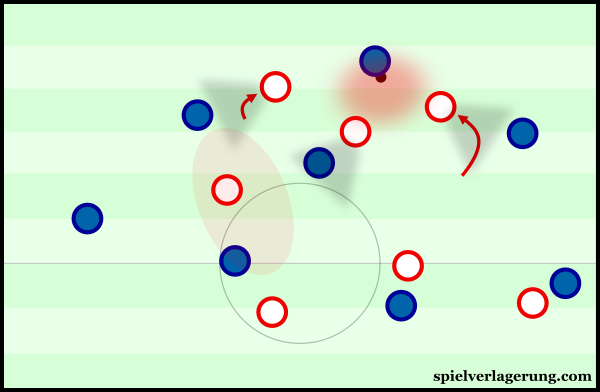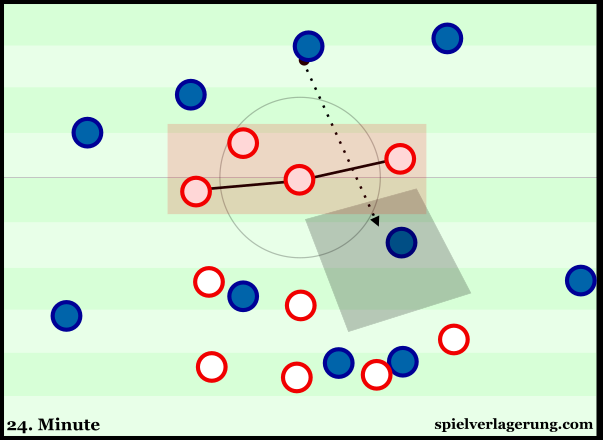Red Bulls’ press posed challenge by direct Sounders
Whilst the majority of the world is fixated on the early developments made in EURO 2016, the MLS returned with the New York Red Bulls hosting Seattle Sounders.
Red Bull pressing
As ever with the Red Bull philosophy, Jesse Marsch’s side took on an aggressive stance in defence and were positioned high into Seattle’s half whilst the Sounders were building their possession. Wright-Phillips was supported closely by Sacha Kljestan whilst the wing pairing of Grella and Sam were nearby in their usual narrow positions. Supported by the dynamic spatial coverage of the two central midfielders, they pressed fairly well as a group in order to force turnovers within the Sounders’ third of the pitch.
Both Grella and Sam were yet again important to the pressing efforts of their team. Positioned in their respective half-spaces, they occupy strategically-strong areas of the pitch which allow them to engage in defensive work in multiple areas of the pitch within little distance. Most importantly, when supporting the central press the pair aided with the presence of additional pressing angles to further constrict the space for the ball-carrier.
It was interesting to see the active pressing of the wide players where, in most systems, they would be somewhat disengaged as a means of inviting the opposition towards the wing. Yet the ball-near winger would instead move higher and engage the ball-carrier whilst covering the full-back option with his shadow. This rather unusual mechanism allowed the Red Bulls to apply greater pressure on the centre-back and was fairly effective at times, even though they decided against utilising the touchline to the extent which most teams do. In the early months of Marsch’s tenure at the Red Bull Arena, his side were more inclined to invite the opposition towards the ball-near flank before upping their intensity, suggesting an interesting shift in his time at the club.
Although in one or two uncertain moments arose in individual duels after the initial press had been beaten, RBNY’s defensive attempts worked well to disrupt Seattle’s possession game. There was one issue which arose in relation to the spacing of the front four. During certain situations when looking to put the opposition under pressure, the vertical coverage was rather flat and they were unable to occupy a sufficient depth of the pitch. This became problematic when spaces behind the back four, especially to the sides of the central midfield, began to open – allowing Sounders a passage through. During wider instances, it forced the full-backs to occupy more advanced positions than they were perhaps comfortable with.
Not only was their spatial coverage lessened, but it meant that often if one player was bypassed, all four were taken out of the game with the opposition free to attack the midfield. An example of this lied in an opening during the 24th minute where the defensive line was required to make a strong covering play. In the example to the right, a defensive breakdown leaves the team with a passing lane completely open between Kljestan and Lloyd Sam. Sounders take advantage and with the flat nature of the RBNY front line, the ball bypasses four players leaving Ivanschitz with a free run at the home side’s back four.
However it was a much different scenario which posed Jesse Marsch’s team with the most questions.
Seattle find potential in direct game
With the front of the Red Bulls’ team focused on regaining the ball from the Sounders defence, 1v1 battles were formed in the back line with the ball-near full-back and centre-back usually occupied. Noticing this opportunity, the away team looked to take advantage and made numerous long balls into the wide channels, with the hopes that the forwards would win their individual battles to retain possession in an advanced position.
Simple and easy to implement, direct play is somewhat of a common antedote against pressing teams as one aims to exploit the space sacrificed in deeper areas as teams adopt a higher position up the pitch. By playing direct to the forwards, they bypass the defensive pressure of the attack and hopefully reach their own attackers with somewhat more space than against a deeper-positioned defence. From a defensive perspective, it also reduces the possibility of losing possession in dangerous areas which will have undoubtedly been a factor against one of the strongest pressing teams in the league.
This strategy was fairly effective on a number of instances within the first 30 minutes as the front three were strong when coming up against the RBNY defence. The pace of the front line was exercised too, particularly in the case of winger Jones who looked to stretch the full-back and contest him in a battle of pace when chasing down said long balls. The Sounders were able to carve out two of the game’s best chances through this tactic, yet many of these long balls failed to materialise attacks.
Sounders’ main issue with this strategy was the starting position of the attacks. As the majority of these long balls were to the wide areas where the 1v1 match-ups could be found, the away side often had a weak starting position upon entering the Red Bulls half. Not only was the receiving player in a physical challenge with his back to the goal, but he found the ball in wide areas within short vicinity to the touchline. Because of this, the Red Bulls were in a good position to quash out any potential threats by closing the ball away towards the byline.
The instances where the pass was low, either to the feet of the receiver or onto a run were largely more profitable. This was the source of the two strong chances mentioned above and it came as a surprise that they didn’t attempt to make greater use of it. Not only was it easier for the player to control and retain possession from the initial pass, but it allowed him to more quickly move the ball on – often inside into a midfield where the Sounders could recycle possession in a stronger and more secure position higher up the pitch.
Whilst the Sounders had some success in making attacks through this new-found direct game, it was the Red Bulls who were superior in their use of possession for the duration of the game. Where the intensity of Marsch’s team restricted the visitors from many spells of sustained possession, his side enjoyed longer spells on the ball with greater control. The strong midfield pairing of McCarty and Felipe offered a valuable dynamic and pressing resistance which the opposition were perhaps lacking. After a strong start they were the more likely side to take the lead and deservedly did so with an albeit somewhat lucky goal as Mike Grella rebounded a distant Kljestan shot.
Second Half Developments
Following the opening 35 minutes, the Sounders began to explore alternative ways of progressing the ball forwards and were able to find more sustained periods of possession. Now protecting the 1-0 lead, the Red Bulls’ defensive intensity dropped as they were more inclined to sit in a mid-block, reserving their higher pressure for triggers and more selective situations.
Despite their more extended spells of possession, the Sounders were unable to find a breakthrough against what is an in-form RBNY defence. One of their mistakes was that they repeatedly looked towards the wider areas of the pitch for answers, where inefficient crossing was one of few tactical options going forward. As a result, they were unable to fashion the same quality of chances which fell to them with the direct game-plan in the first half and with the opposition more content to take a more reserved approach to the game, finding that equaliser proved a tough challenge.
Able to play more conservatively, the Red Bulls shifted their focused towards midfield pressing in what was more of a mid-block. Where previously the pressing was used as a means of chance creation and forcing turnovers high into the Sounders’ half, now it was closer a means of maintaining stability in defence. The Sounders’ task was exacerbated after Mike Grella notched a second in the 60th minute and attacking midfielder Kljestan was immediately replaced by Aurélien Colin who dropped into the defensive line as RBNY moved to a 5-4-1. Despite lacking a degree of vertical compactness within this new shape, the home side were fairly secure with greater coverage of the defensive line with the additional man.
As the game wore on, the Red Bulls ball circulation also took a stability-focus as they retained possession for long periods whilst being more selective in their decisions to move forward. They tried to deprive the Sounders of possession and disrupt their attacking rhythms and whilst the visitors had a couple of decent breakaways, Marsch’s side did enough to secure yet another clean sheet.
Conclusion
Despite there not being a clearly superior team throughout the match, the Red Bulls perhaps edged their opposition with some strong individual performances and game management. Their press was posed an interesting challenge in Sounders’ direct play and despite struggling at times in the first half, maintained their stability for the majority of the game. Marsch’s change following the 2nd goal allowed the Red Bulls to better protect their box and although they were far from ‘parking the bus’, their greater focus on stability was a useful case of game management.






Keine Kommentare vorhanden Alle anzeigen